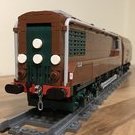Search the Community
Showing results for tags 'signalbox'.
Found 2 results
-
Hi everyone! This model represents the design of Pennsylvania Railroad's standard design two-story wood frame interlocking towers and is deffently a part of railway history. I was attempting to show admiration for this magnificent structure! It comprises 2600 parts and is constructed on a 32*32 plate. John, a railroad worker, oversees everything here. He is a devoted railway enthusiast, and everyone along the route is familiar with him. Therefore, whenever you hear a train signal, it's the engine driver saying 'Hi' to John :) And, as all my Signal Boxes, I devote this project to to my Grandfather (railworker) P.S. If you like it - you can support it in current BDP4 https://www.bricklink.com/v3/designer-program/series-4/1311/Interlocking-Tower-1885
-
I'm unsure whether or not I should be posting this in this list or on the Technic list, but I guess that it's more topic-specific here. There are a lot of vehicles over on the Technic list, and that's fine. Technic LEGO probably best lends itself to constructing vehicles of various types and there are many fine and talented exponents of that art over there. But I did start wondering what else might be made from LEGO Technic; something without wheels, motors, PF or remote control. After a bit of a brainstorm my mind settled on the good old-fashioned mechanical signalbox lever frame. There have been very few previous attempts at such a build (at least as far as I can tell from my research), so I thought it would be interesting to see if I could make some headway. I'm not terribly technically minded, but this was something that I do have a reasonable understanding of, and it's complicated enough to be challenging to design and build. The starting point was to make the model fully functional and as realistic as possible, which means that any notions of scaling correctly would go out of the window (luckily that's an approach I'm very comfortable with). Therefore I wanted not just to have the lever frame but the interlocking frame too. Sadly Technic does not lend itself well to the conventional tappet method of interlocking, so I would have to devise my own system that did suit the medium better using sliding bars with pegs engaging with holes. I also wanted to include the catch plate mechanism on each lever. Fortunately for my sanity I haven't kept a tally of the number of hours I spent brainstorming and then trying things out in LDD. As I said I'm not the most adept at technical matters, so this really has been a labour of love. However, I got there in the end and came up with a mechanism that looked good in digital form. Having done so I cast around for a prototype that I could recreate and settled upon Downham (the station is now called Downham Market, correctly reflecting the name of the town) between Ely and Kings Lynn in Norfolk as it was around 1974. It's a modest frame with 22 operational levers at this stage operating both points and signals. Downham at this time still had both an Up and Down yard as well as privately operated sidings, so it's an interesting location with lots of operational potential. This is the LDD render of the lever and interlocking frames without the locking bars. My poor little netbook couldn't cope with the whole thing in one file so each had to be designed separately. And this is the completed frame. It took a day and a half to assemble and, while 22 levers sounds quite modest (and is when compared to other locations on the network), the actual result is a bit of a monster. It looks more like a Wurlitzer organ than anything else. A close-up view of the interlocking system. You can see how it should work with the pegs engaging with holes to either lock or release levers in the frame. The idea behind interlocking is to prevent collisions and other mishaps on the railways by physically stopping the signalman from operating certain points or signals. This is the catch system on one of the levers. As is the case in a real signalbox, the lever must be released from the catch plate by operating the handle at the top of the lever before it can be pulled. A signalman would be familiar with the position and function of all the levers in his signalbox, but just in case each one is colour coded (as per British practice) and identified by a plate. There's more on my Flickr page. So, does it work? Well, yes and no. But mostly no. The catch plate system works brilliantly. Admittedly because it uses a rubber band it can be forced, but it's not easy to do so. But it's in the interlocking frame where things aren't so great. Part of this is because I designed the frame to be modular so that it can be expanded as required. A small prototype frame lead me to believe that the level of flex would be acceptable, but it turns out that at full size the flex is a significant problem. Luckily I designed the frame so that it could sit on baseplates which will almost completely eliminate flex altogether, and so I have some on order. But the biggest problem is that the various parts of the interlocking system need to stay perfectly aligned in order for it to work properly, but they simply refuse to do so. Levers that are meant to be locked can still be operated while others that are meant to be released remain steadfastly jammed because the locking bars do not move as they are designed to do. Part of this is because the friction in the system needs tuning (for which I have replacement parts on order) but mostly because I underestimated what would be needed to keep all the parts in correct alignment. Therefore I've had to design structures to add to the frame that I hope will keep the various parts in line. The locking bars themselves still require a redesign in order to work with these modifications, but that is next on my list. Hopefully these remedies will be enough to have the frame working smoothly. If these fail to address the problems the next area of attention will be the sliding bars that drive the interlocking frame. After that I'll be out of ideas. I hope you like it. I'm having a lot of fun with it and am proud of what is my largest MOC to date. There are more updates planned which I hope to reveal as time goes on.
- 15 replies


